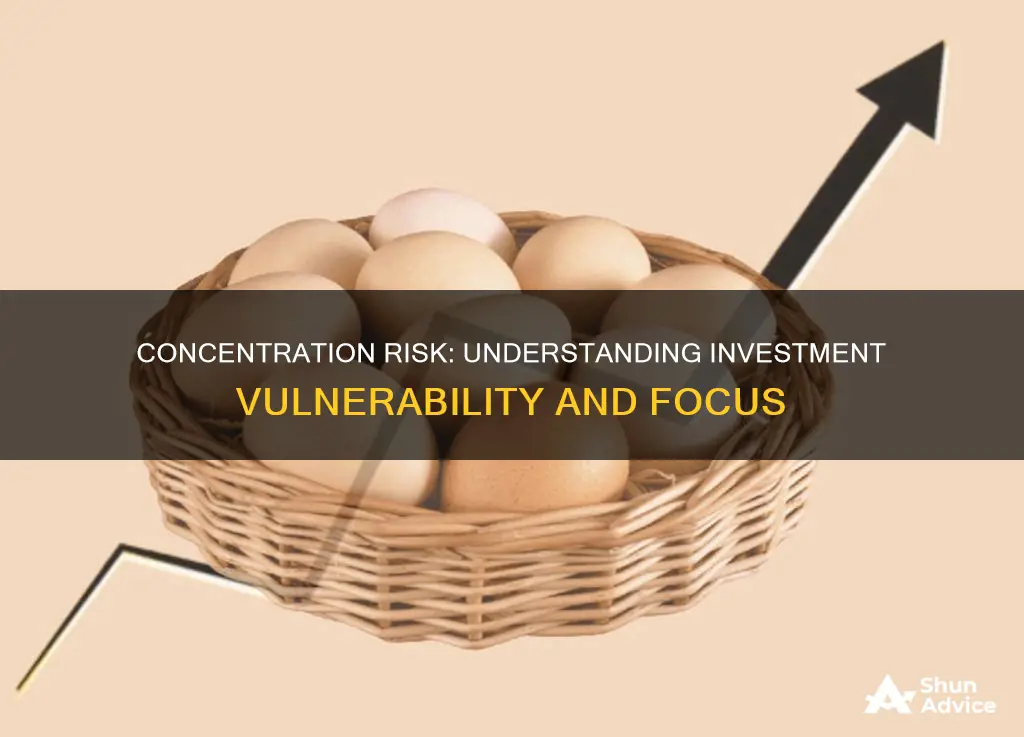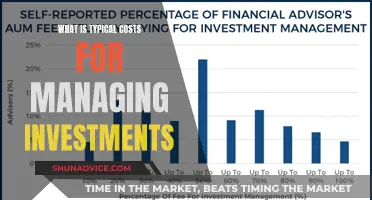
Concentration risk is a term used in investment management to describe the level of risk in a portfolio arising from a single security, sector or country. Concentration risk is also referred to as 'putting all your eggs in one basket'. This is because a portfolio with a large portion of its holdings in a particular investment, asset class or market segment is more vulnerable to amplified losses. Concentration risk is usually monitored by risk functions, committees and boards within commercial banks and is normally only allowed to operate within proscribed limits.
| Characteristics | Values |
|---|---|
| Definition | Concentration risk is a banking term describing the level of risk in a bank's portfolio arising from concentration on a single counterparty, sector or country. |
| Other uses | The concept is used in other financial and non-financial sectors, including investment management, the economic analysis of monopolies, and epidemiology. |
| Management | Concentration risk is usually monitored by risk functions, committees and boards within commercial banks and is normally only allowed to operate within proscribed limits. It is also monitored by banking regulators and generally attracts a higher capital charge in banking regulation. Concentration risk is managed by concentration risk limits, and there are many techniques for quantifying it. |
| Diversification | A diversified portfolio tends to be harder to achieve than simply following the mantra to steer clear of putting all your investment eggs in one basket. |
What You'll Learn

Concentration risk in investment management
Concentration risk is a term used in banking and investment management to describe the level of risk in a portfolio arising from a single counterparty, sector or country. In other words, it is when a single security or a particular sector of the market comprises a significant portion of your portfolio.
Concentration risk is usually monitored by risk functions, committees and boards within commercial banks and is normally only allowed to operate within proscribed limits. It is also monitored by banking regulators and generally attracts a higher capital charge in banking regulation.
There are two types of concentration risk, based on the sources of the risk. Concentration risk can be managed by concentration risk limits and there are many techniques for quantifying it, such as using concentration indices to measure the level of concentration in the portfolio.
The first step in managing concentration risk is to understand how it might occur. Concentration can be the result of a number of factors, such as a conscious decision to invest more of your money in a given asset or asset class because you believe it will outperform its peers or an index.
Kids' Guide to Saving and Investing Wisely
You may want to see also

Concentration risk in the economic analysis of monopolies
Concentration risk is a term used in banking and investment management to describe the level of risk in a portfolio that arises from a large portion of holdings being in a particular investment, asset class, sector or country. Concentration risk is usually monitored by risk functions, committees and boards within commercial banks and is normally only allowed to operate within proscribed limits.
Concentration risk is also a concept used in the economic analysis of monopolies. In this context, concentration risk refers to the risk of a single firm or a small number of firms controlling a large portion of a market. This can lead to a lack of competition and higher prices for consumers. The Herfindahl-Hirschman Index is a measure of market concentration that can be used to assess the level of concentration risk in a market.
The risk of concentration in a portfolio can be mitigated by diversifying investments across different asset classes, sectors and countries. This reduces the impact of any one investment on the overall performance of the portfolio. However, it can be challenging to achieve a truly diversified portfolio, as it requires research and careful planning.
There are several techniques for quantifying concentration risk, including the use of concentration indices such as the Gini coefficient, Hannah-Kay index, Hall-Tideman index and Theil entropy index. These indices measure the level of concentration in a portfolio and can help investors understand and manage their exposure to concentration risk.
Understanding Managed Portfolio Investment Strategies and Benefits
You may want to see also

Concentration risk in epidemiology
Concentration risk is a term used in investment to describe the level of risk in a portfolio arising from a single security, sector or country. In other words, it is the risk of amplified losses that may occur from having a large portion of your holdings in a particular investment, asset class or market segment relative to your overall portfolio.
There are several techniques for quantifying concentration risk, including the use of concentration indices such as the Gini coefficient, Herfindahl-Hirschman index, Hannah-Kay index, Hall-Tideman index, and Theil entropy index. These indices can be used to measure the level of concentration in a portfolio or population and to compare the distribution of risk factors across different groups.
Managing concentration risk in epidemiology involves monitoring and addressing the factors that contribute to the concentration of risk in a population. This may include interventions such as education and outreach programmes, policy changes, or the development of new treatments or prevention strategies. By reducing the concentration of risk factors, public health officials can improve health outcomes and reduce health disparities in the population.
Crafting Investment Contracts: A Guide to Securing Your Future
You may want to see also

How to manage concentration risk
Concentration risk is when a single security or a particular sector of the market comprises a significant portion of your portfolio. This means that your portfolio becomes highly dependent on the performance of that individual component of the broad investment universe.
To manage concentration risk, it is important to first understand how it might occur. Concentration can be the result of a number of factors, including intentional concentration, where you might believe a particular investment or sector will outperform its peers or an index, so you make a conscious decision to invest more of your money in a given asset or asset class.
There are many techniques for quantifying concentration risk, including:
- Using concentration indices (e.g., concentration portfolio, Gini coefficient, Herfindahl-Hirschman index, Hannah-Kay index, Hall-Tideman index, and Theil entropy index) to measure the level of concentration in the portfolio.
- Using transaction cost analysis to estimate market impact.
- Incorporating turnover constraints into portfolio analysis.
China's Tech Grip on India's Investment Scene
You may want to see also

Types of concentration risk
Concentration risk is a term used in banking and investment to describe the risk of a large portion of a portfolio being dependent on a single security, sector, or country. This can lead to amplified losses if that component of the portfolio underperforms.
There are two types of concentration risk, based on the sources of the risk. These are:
- Intentional concentration: This occurs when an investor believes that a particular investment or sector will outperform its peers or an index, and therefore makes a conscious decision to invest more of their money in that asset or asset class. This can lead to a lack of diversification in the portfolio, which can increase the risk of losses.
- Unintentional concentration: This can occur when an investor is not aware of the concentration risk in their portfolio, or when the concentration is due to factors outside of the investor's control. For example, a particular sector or asset class may become more concentrated due to market forces or economic cycles. This type of concentration risk can be mitigated through regular portfolio analysis and rebalancing.
There are several techniques for quantifying and managing concentration risk, including the use of concentration indices, transaction cost analysis, and turnover constraints. Concentration risk is typically monitored by risk functions, committees, and boards within commercial banks, and is generally only allowed to operate within prescribed limits.
Investing in Equipment: A Smart Move to Boost Equity
You may want to see also
Frequently asked questions
Concentration risk is when a single security or a particular sector of the market comprises a significant portion of your portfolio. This means that your portfolio becomes highly dependent on the performance of that individual component.
A diversified portfolio is key to avoiding concentration risk. This means not putting all your investment eggs in one basket.
There are many techniques for quantifying concentration risk, including concentration indices, transaction cost analysis, and turnover constraints.







